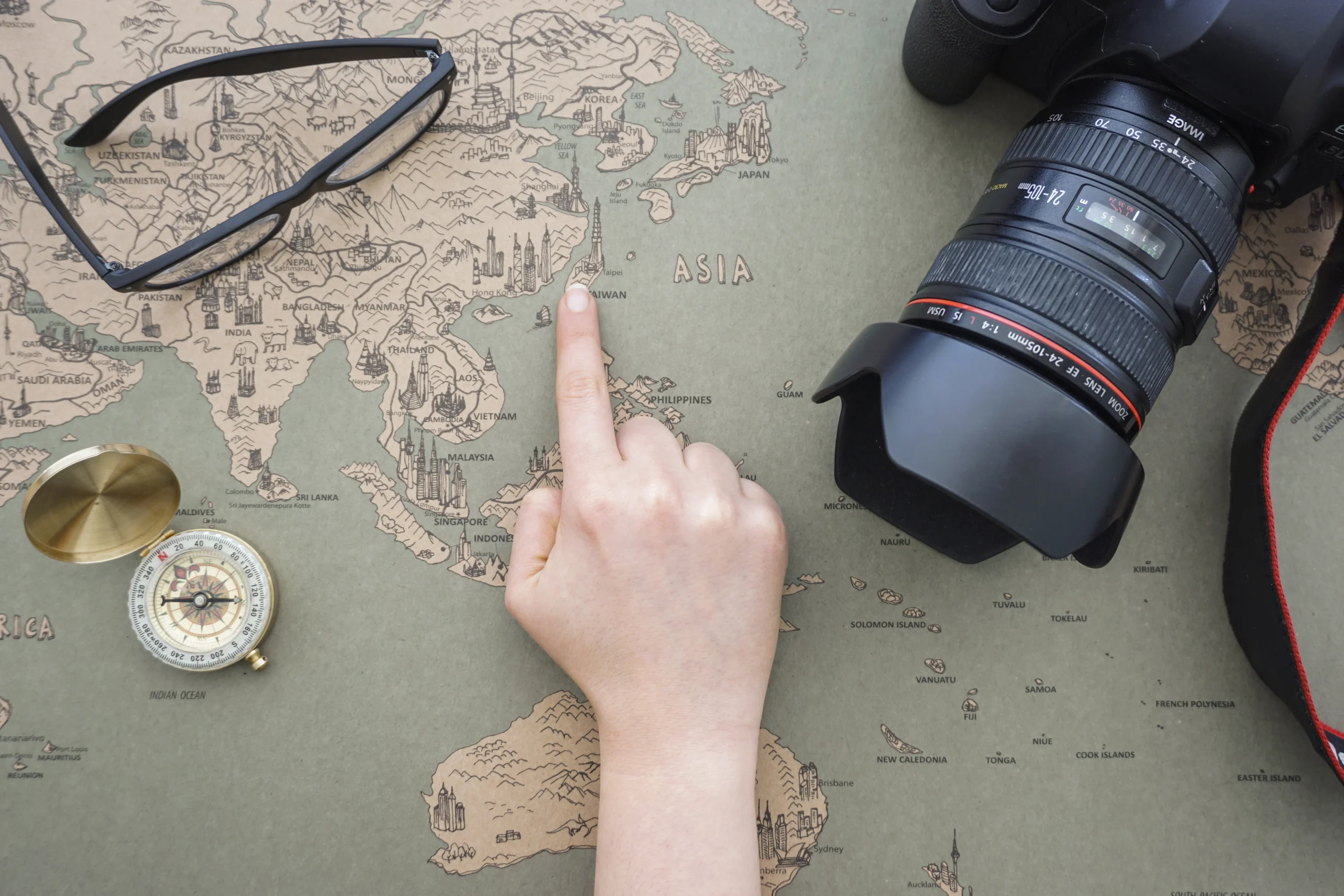
Ultimate Guide to Travel Photography — Capture the World Like a Pro
Introduction: Turning Travel Moments into Masterpieces
Travel and photography are a perfect pair. Every journey tells a story, and every photo captures a piece of it — the colors of Morocco’s markets, the sunrise over Dubai’s desert dunes, or the calm of Santorini’s blue domes.
Whether you’re a casual traveler snapping moments for Instagram or an aspiring photographer aiming for stunning portfolios, travel photography helps you relive experiences and share them with the world.
In this guide, you’ll learn how to capture better travel photos, from mastering light and composition to choosing the right gear and editing for perfection.
What is Travel Photography?
Travel photography is more than just taking pictures of places — it’s the art of storytelling through visuals. It includes landscapes, portraits, street life, architecture, food, and culture — all through the lens of exploration.
A powerful travel photo should:
- Evoke emotion
- Capture culture and authenticity
- Showcase beauty and diversity
- Tell a story without words
Section 1: Choosing the Right Gear for Travel Photography
Cameras: DSLR vs Mirrorless vs Smartphone
DSLR Cameras – Excellent for professionals seeking high-quality detail and manual control.
Mirrorless Cameras – Compact, lightweight, and perfect for travelers who want DSLR quality with portability.
Smartphones – Modern phones are powerful enough for social media content creation.
Essential Lenses
- Wide-angle lens (16–35mm) — Perfect for landscapes and architecture.
- Prime lens (50mm) — Great for portraits and detail shots.
- Telephoto lens (70–200mm) — Ideal for wildlife or distant objects.
Accessories You Should Carry
- Lightweight tripod for stability
- Extra batteries and memory cards
- Polarizing filter for better skies and reflections
- Camera cleaning kit
- Waterproof camera bag
Section 2: Mastering Composition and Lighting
Rule of Thirds
Imagine your frame divided into nine equal parts — place your subject along the lines or intersections for a balanced composition.
Leading Lines
Use natural lines like roads, bridges, or rivers to guide the viewer’s eyes toward the subject.
Golden Hour Photography
The golden hour — shortly after sunrise or before sunset — creates warm tones, soft shadows, and magical light for stunning travel portraits and landscapes.
Frame Within a Frame
Use arches, windows, or natural elements to frame your subject — it adds depth and focus to your travel photos.
Section 3: Capturing Different Travel Photography Styles
Landscape Photography
Showcase vast mountains, deserts, oceans, or city skylines. Use wide lenses and play with foreground elements to create depth.
Street Photography
Capture the heartbeat of a city — local life, markets, traditions, and people. Always be respectful and seek permission when needed.
Architecture Photography
Highlight the symmetry, textures, and patterns of buildings — from modern skyscrapers to historic monuments.
Food Photography
A huge part of travel is food! Use natural light, vibrant backgrounds, and close-up shots to make dishes look irresistible.
Wildlife Photography
For safaris or nature tours, use telephoto lenses and patience. Respect wildlife by keeping a safe distance.
Cultural and Portrait Photography
Engage with locals, learn their stories, and capture expressions that represent authentic cultural identity.
Section 4: Top Destinations for Stunning Travel Photography
- Dubai, UAE — Futuristic architecture, desert dunes, luxury skylines.
- Iceland — Northern lights, glaciers, and waterfalls.
- Japan — Cherry blossoms, neon cities, and traditional temples.
- Italy — Rome’s ruins, Venice’s canals, and Tuscany’s landscapes.
- India — Vibrant festivals, diverse cultures, and historical landmarks.
- Peru — Machu Picchu and the Andes.
- Morocco — Colorful souks and desert sunsets.
- New Zealand — Epic mountain ranges and lakes.
Section 5: Editing Tips for Professional Results
Use Editing Software
- Adobe Lightroom — Best for color correction and tone balance.
- Photoshop — For detailed retouching and creative editing.
- Snapseed or VSCO — Great mobile apps for travelers.
Basic Editing Workflow
- Adjust exposure, contrast, and highlights.
- Correct color temperature and white balance.
- Crop and straighten your image.
- Enhance details using sharpening and clarity.
- Apply subtle filters to maintain a natural look.
Stay Consistent
If you’re building a travel blog or Instagram page, use consistent tones or presets to create a unique visual identity.
Section 6: Ethical Travel Photography — Capturing with Respect
- Always ask for permission before photographing people.
- Avoid exploiting cultures or private spaces.
- Don’t disturb wildlife or damage nature for photos.
- Share positive, authentic representations of destinations.
Responsible photography preserves the dignity and beauty of the world you’re capturing.
Section 7: Pro Tips for Better Travel Photography
- Learn basic manual settings: ISO, aperture, shutter speed.
- Shoot in RAW for better editing flexibility.
- Research locations in advance — know where the light will fall.
- Keep your camera ready — magic moments happen unexpectedly.
- Backup your photos regularly using cloud or hard drives.
- Tell a story with every shot — emotion beats perfection.
Section 8: Building a Travel Photography Portfolio or Blog
- Create a dedicated travel photography website or Instagram portfolio.
- Collaborate with tourism boards or travel agencies.
- Write travel photo blogs sharing your journey and gear setup.
- Participate in photography contests and exhibitions.
Your visuals can inspire others to explore the same destinations.
Frequently Asked Questions (FAQ)
- What is the best camera for travel photography?
- For beginners, mirrorless cameras like Sony Alpha or Canon R50 are great — compact and powerful.
- How do I take professional-looking travel photos on a phone?
- Focus on lighting, composition, and stability. Use gridlines, avoid digital zoom, and edit in Lightroom Mobile.
- What’s the best time to shoot outdoors?
- Early morning and late evening (golden hours) offer the best natural light.
- How can I make my photos unique when everyone visits the same spot?
- Experiment with angles, capture locals or small details, and add human elements for storytelling.
- How do I start earning from travel photography?
- Sell prints, license your photos on platforms like Shutterstock, or collaborate with brands and tourism boards.
Conclusion: Travel Through Your Lens
Travel photography is not just about pictures — it’s about perspective. Each photograph you take is a piece of your journey, a frozen moment that tells a thousand stories.
Whether you’re photographing the bustling streets of Tokyo, the deserts of Dubai, or the serene Alps of Switzerland, remember: the best camera is the one that helps you see beauty in the moment.
So pack your bags, grab your camera, and go capture the world — one click at a time.
Navigation
Head Office
Sheikh Zayed Rd,
Trade Centre,
Trade Centre 1,
Dubai
Branch Office
Sharjah Media City,
Sharjah – 500001,
Dubai,
United Arab Emirates.
